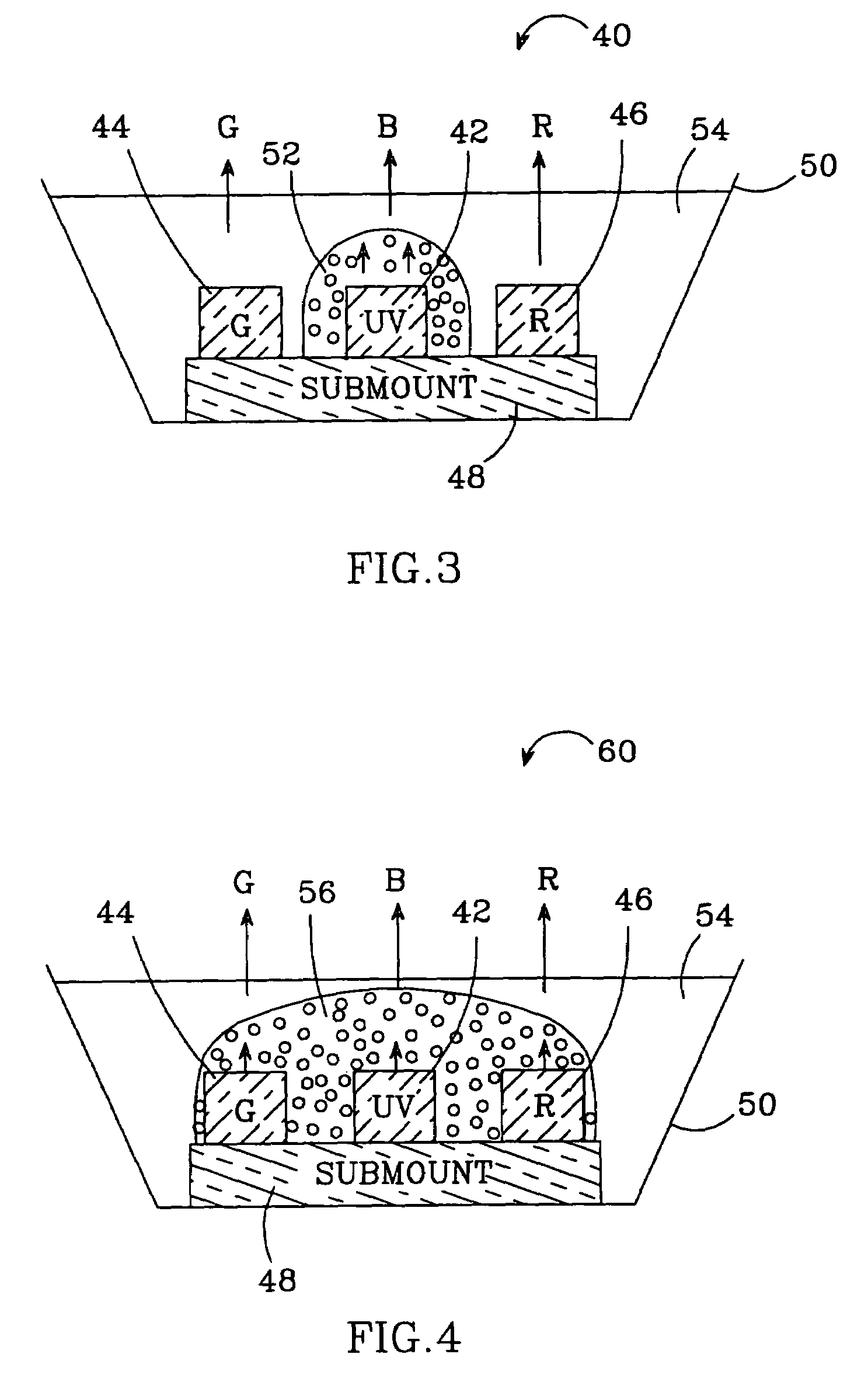One
disadvantage of conventional LEDs used for lighting applications is that they cannot generate white light from their active
layers.
One
disadvantage of this approach is that it requires the use of multiple LEDs to produce a single color of light, increasing the overall cost and complexity.
Combining different LED types to form a white lamp can require costly fabrication techniques and can require complex control circuitry since each device may have different electrical requirements and may behave differently under varied operating conditions (e.g. with temperature, current or time).
However, conventional blue LEDs are too dim for many general lighting applications that currently make use of filament-based or fluorescent lamps.
While improvements in blue LED efficiency and output power would be beneficial in increasing the light output from white LEDs, a number of other factors exist which limit the performance of such devices.
For example,
phosphor materials have a finite conversion efficiency, resulting in “conversion loss” since a portion of the absorbed light is not re-emitted as downconverted light.
Additionally, each time a higher energy (e.g., blue)
photon is converted to a lower energy (e.g., yellow)
photon,
light energy is lost (Stokes loss), resulting in an overall decrease in white LED efficiency.
This reduction in efficiency increases as the gap between the wavelengths of the absorbed and re-emitted (downconverted) light increases.
Finally, for blue LEDs to emit an output
light flux sufficient for room illumination, the LED chips themselves can become very hot, causing damage the component device layers of the LED
chip itself, or degrading surrounding encapsulation or downconverting media.
Another disadvantage of the above white
light emitter arrangements (red+green+blue LEDs or blue LEDs combined with yellow phosphors) is that they do not produce the optimal
spectral emission necessary for both high
efficacy and
high color rendering.
While it is possible to achieve fairly high values of
efficacy and color rendering with this approach,
wavelength ranges exist in which it is difficult to obtain high-efficiency LEDs (e.g. approximately 550 nm).
As a result, it is difficult to achieve both high efficacy and
high color rendering index with low manufacturing cost and high yield.
This can be particularly problematic when spectral requirements call for high efficiency green LEDs, since such LEDs have only been realized in the (In, Ga, Al)N
system and are typically subject to low yield and strong wavelength and emission variations with operating conditions such as drive current and temperature.
While more simplified white lamps may be realized using only two LEDs emitting at complimentary colors (e.g. blue, yellow), it is exceedingly difficult to achieve
high color rendering coefficients in such lamps, primarily due to the lack of any
red light in the resulting spectrum.
Since the resulting light is typically deficient in one of the primary colors, lamps fabricated in this manner display poor color rendering.
However, suitable red phosphors having high conversion efficiency and the desired excitation and emission characteristics have yet to be reported.
Even if such red phosphors were available, they would be subject to significant energy (Stokes) losses due to the conversion of
high energy blue or UV photons to lower energy red photons.
One of the disadvantages of the Shimizu lamp is that blue LEDs are not as efficient as other LEDs emitting at other wavelength spectrums and a limited number of phosphors are available for
luminescence from a blue wavelength of light.
Another disadvantage is that with red and blue LEDs placed side by side, the projected light may have an asymmetric appearance such that the light appears red on one side and blue on the other.
Since
phosphor particles typically must be on the order of at least a few microns
diameter to achieve high conversion efficiency (i.e., much larger than the wavelength of blue or yellow light) and particles which are larger than the wavelength of light are poor scatterers, covering one or both of the LEDs with
phosphor generally does not adequately scatter the LED light to combine the different wavelengths.
This can be a particular problem with large area LEDs used for high power, high output.
Another disadvantage of a number of the embodiments disclosed in Shimizu is that they show blue and red LEDs placed on top of one another and then covered by the phosphor.
This can result in the shorter wavelength
blue light being absorbed by the component device layers (e.g., active layers, metallization layers) of the red LED device, thereby decreasing the
overall efficiency of the lamp.
Also, by covering the red LED with phosphor some of the phosphor particles may absorb some of the
red light, which can result in a loss of efficiency because it is generally not possible to “up-convert” the absorbed
red light to higher energy
green light in an efficient manner.
Such approaches are generally not effective and can decrease efficiency by interfering with the purpose of the lens, which is to reduce backscattering of light at the lens /
air interface and possible subsequent re-absorption within the body of the lamp or LED.
 Login to View More
Login to View More  Login to View More
Login to View More 


